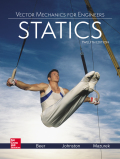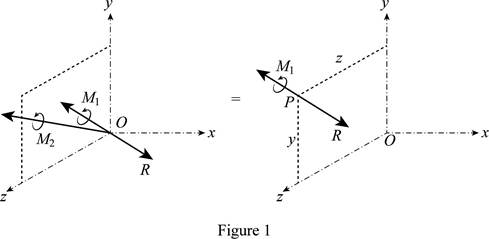
Concept explainers
(a)
The resultant force.
(a)
Answer to Problem 3.139P
The resultant force is
Explanation of Solution
Write the equation of the distance between AC.
Here, the distance between AC is
Write the equation of the distance between BD.
Here, the distance between BD is
Write the equation of the momentum about AC.
Here, the momentum about AC is
Write the equation of the momentum about BD.
Here, the momentum about BD is
Write the equation of resultant force.
Here, the resultant force is
Conclusion:
Substitute,
Substitute,
Substitute,
Substitute,
Substitute,
The magnitude of the resultant force,
Thus, the resultant force is
(b)
The pitch of the wrench.
(b)
Answer to Problem 3.139P
The pitch of the wrench is
Explanation of Solution
Write the equation of pitch of the wrench.
Here, the pitch of the wrench is
Since, the
Here, the constant is
Write the expression for the constant is,
Write the equation of momentum.
Here, the momentum is
Rewrite the expression for the momentum of the wrench is,
Conclusion:
Substitute,
Substitute,
Thus, the pitch of the wrench is
(c)
The point at which the axis of wrench intersects the yz-plane.
(c)
Answer to Problem 3.139P
The axis of wrench intersects the yz-plane at
Explanation of Solution
The diagram for the force-couple system is given below:

Refer fig 1,
Write the equation for the force couple system for the wrench.
Here, the momentum is
Write the expression for the momentum at which the wrench intersects the xz-plane.
Here, the position vector is
Write the expression for the position vector is,
Here, the coordinates are
Conclusion:
Substitute,
Substitute,
Substitute,
Comparing the coefficients of the y and z components both sides,
Therefore, the axis of wrench intersects the yz-plane at
Want to see more full solutions like this?
Chapter 3 Solutions
Vector Mechanics for Engineers: Statics
- H.W: 1-A Pitot tube is inserted in the pipe of 30 cm I.D. The static pressure head is 10 cm Hg vacuum, and the stagnation pressure at center of the pipe is 0.981 N/cm2 gauge. Calculate the discharge of water through the pipe if u/umax = 0.85. Take Cp = 0.98.arrow_forward2- A Pitot tube is used to measure the air flow rate in a circular duct 60 cm I.D. The flowing air temperature is 65.5°C. The Pitot tube is placed at the center of the duct and the reading R on the manometer is 10.7 mm of water. A static pressure measurement obtained at the Pitot tube position is 205 mm of water above atmospheric. Take Cp = 0.98, = 2.03 x 10-5 Pa.s Calculate the velocity at the center and the average velocity. Calculate the volumetric flow rate of the flowing air in the duct.arrow_forward4. The following assembly is made of an Aluminium rod (E = 500 MPa). The diameter of the rods is 25mm and 50mm. The ends of the rod are fixed at A and C. A 400 mm 1400 kN B 800 mm (i) Is this a statically indeterminate problem? Why? (ii) Can you draw the axial load diagram without first resolving the reaction forces at A and C? (iii) Determine the reaction forces at A and C. (iv) Draw the axial load diagram. (v) Determine the deformation at section BC.arrow_forward
- Solve this problem and show all of the work. Show how the moments are calculated and draw a diagramarrow_forwardProblem: Textbook Problem 10.52 and 10.53. Determine the moment of inertia of the area about the x- axis and the y-axis. 3 in. 3 in. 6 in. 2 in. 4 in. xarrow_forwardSeveral reactions are carried out in a closed vessel. The following data are taken for the concentration of compounds A, B, and C [grams per liter] as a function of time [minutes], from the start of the reaction. Show the resulting data and trendlines, with equation and value, on the appropriate graph type (rectilinear, semilog, or log–log) to make the data appear linear.arrow_forward
- Solve this problem and show all of the workarrow_forwardSolve this problem and show all of the workarrow_forwardThe 4-lbs piece of putty is dropped 12 ft onto the 16-lbs block initially at rest on the two springs, each with a stiffness k = 5 lbs/in. Calculate the additional deflection d of the springs due to the impact of the putty, which adheres to the block upon contact.arrow_forward
- Solve this probem. Draw the diagram and show how the moments are calculated in all of the directionsarrow_forwardSolve this problem and show all of the workarrow_forwardThe 4-lbs piece of putty is dropped 12 ft onto the 16-lbs block initially at rest on the two springs, each with a stiffness k = 5 lbs/in. Calculate the additional deflection d of the springs due to the impact of the putty, which adheres to the block upon contact.arrow_forward
 International Edition---engineering Mechanics: St...Mechanical EngineeringISBN:9781305501607Author:Andrew Pytel And Jaan KiusalaasPublisher:CENGAGE L
International Edition---engineering Mechanics: St...Mechanical EngineeringISBN:9781305501607Author:Andrew Pytel And Jaan KiusalaasPublisher:CENGAGE L
